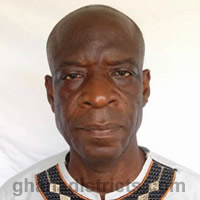Introduction
The population size and age-sex composition have broad implications for the socio-economic development of the district. Issues concerning the welfare of the people including access to social amenities and services are influenced by demographic characteristics. The changes in a country’s population are mainly through fertility, mortality and migration levels, which to a large extent, are influenced by age-sex composition.
The 2010 Census, like all other Censuses undertaken in the country, was a "de facto" count of each person present in Ghana irrespective of nationality. This chapter examines information on the demographic characteristics of the population in the district. It discusses the population size, sex and dependency ratios, migration patterns, fertility, mortality issues and migration patterns.
Population Size and Distribution by locality
Table 2.1 presents the population size by locality of residence by district, region and sex. It indicates that Akyemansa District recorded a total population of 97,374 during the 2010 population and housing census. The population of the district constitutes 3.7 percent of the total population of the Eastern Region. Females constitute 50.7 percent and males 49.3 percent. The district is predominantly rural (65.1%) with only 34.9 percent being urban localities. This implies that out of every 10 people in Akyemansa close to seven people reside in rural areas with three in the urban areas.
Table 2.1 further indicates that about 52.0 percent of females reside in the urban areas compared to 48.0 percent of males while equal proportions of (50%) both sexes are in the rural localities. The sex ratio for the district is 97.2 males per 100 females. The urban localities have a sex ratio of 92.2 males per 100 females while the rural localities have a sex ratio of 100 which means that for every one male there is equally one female.
Age- Sex Structure
Age Structure by Sex and Age
Table 2.2 is on the age- sex structure of the district. Out of a total population of 97,374 in 2010, the population below 15 years constitutes the largest proportion of 42.1 percent, an indication of the youthfulness of the population. The proportion of males (44.1%) in this age group is higher than the female proportion (40.2%). The age group 30-59 constitutes the second highest proportion (26.4%), majority of whom are females (27.5% females against 25.2% males). The age group 15 years and older constitute the working age group.
The 15-24 age group constitutes the third largest proportion of the population (17.5%) with a slightly higher proportion of males (17.8%) than females (17.1%). The proportion of the population 25-29 years is however smaller, recording a total of 6.2 percent: males (5.6%) and (6.7%) female. This situation might possibly be as a result of migration of young people from the area. The 60+ population make up 7.9 percent of the population with more females (8.5%) compared to males (7.2%).
Age Structure by Sex
Table 2.3 shows the age structure by sex of the district. The table shows that the age structure and the sex composition of the district follow both the national and regional patterns. It shows a youthful population structure that is characteristic of a developing country such as Ghana with a high fertility. The table shows a broad-based age-sex structure with a concentration of children at younger ages (0-14). The percentages gradually reduce in the higher age groups as the population ages with small percentage of the elderly population 60+. The table also shows that more females survive to the advanced ages even though there are more males than females in the age group 0-4 years.
Dependency Ratio
Age dependency ratio is the relation between persons in the dependent ages (under 15 years and 65 years and older) and persons in the economically productive age group 15-64 years. Child dependency ratio is the ratio of people under age 15 to those between 15-64 years while old age dependency ratio is the relationship between people who are 65 years and older to those who are 15-64 years old.
The age dependency ratio is used as an indicator of economic burden of the productive portion of a population must carry, even though some persons defined as dependent on the productive portion of a population are producers and some persons in the productive ages are economically dependent.
Table 2.4 presents the age dependency ratio by sex of the district. The relationship between the populations aged 0-14 years and 65 years and above on one hand and the population aged 15-64 years constitutes the age dependency. The table shows a high total dependency ratio of almost 92 percent (91.7) in the district.
In other words, there are almost 92 dependents per 100 working persons. As expected child dependency ratio (80%) is higher than old age dependency (10.9%) an indication of the youthfulness of the population represented by the large proportion of the population 0-14 (42.1%) years compared to the working age population 15-64 (52.2%).
The rather smaller old age dependency is also an indication of the exit of the population either through death or migration as they grow older. The table also shows a higher proportion of males in the 0-14 age group compared to females. There are however a higher percentage of females than males in the working age population (15-64) and the 65+ age group.
With the exception of the old age dependency ratio which registered a higher rate for females (12) compared to males (9.7), there is a higher total dependency as well as child dependency with regard to males. There is obviously a higher proportion of males in the age group 0-14 and a higher proportion of females in the working age group and the 65+ age group. There are more males in the 0-14 years (44.1%) than females (40.2%).
There are however more females in the 15-64 age group (53.4%) than males (51.0%). There are also a higher female old age dependency ratio (12.0%) compared to males (9.7%). An indication of the higher life expectancy of females relative to their male’s counterpart.
Fertility, Mortality and Migration
Population is dynamic and not static. The three components of demographic change (increase or decrease) are fertility, mortality and migration. The combination of both natural increase and migration influences the process of population distribution and redistribution. The redistribution through migration is usually affected by other geographic and socio-economic factors (push and pull factors). Some of these factors include the distribution and use of natural resources and infrastructural development as well as policies, and programmes of governments or development partners.
Table 2.5 indicates a total population of 97,374 for the Akyemansa District as at the 2010 census with a total female population within the age group 15 to 49 years being 22,080. The General Fertility Rate according to the table is 116.1 for all the women with total births as 2152 at the time of the census. The Crude Birth Rate for the district according to the table is 27.7 with the Total Fertility rate of 4.3 for the district.
The TFR for the region 3.5 is lower than that of the district which simply means that there are more births to women within the reproductive ages in the district than the region. The CBR as well as the GFR rate for the region is lower than that which pertains in the district meaning that there are more births in the district than in the region.
Migration
Birth place of a person has been defined as the locality of usual residence of the mother at the time of birth (PHC, 2010). The total number of migrants who were enumerated in the district is 23, 685 representing 24.3 percent of the total population. Migrants who have lived in the district for more than 20 years recorded the highest percentage of 30.6 percent while those with less than one year of residence are the lowest (12.4%).
Persons who were born elsewhere in the Eastern region are 10,311 representing 10.6 percent of the total population. The highest proportion of persons born elsewhere in the region have lived in the district for over 20 years (28.3%), followed by those who have been resident in the district for 1-4 years (24.0%).
Residents with less than one year stay in the district are the least (12.9%). Of persons born in another region but have moved to the Akyemansa District, Central Region recorded the Ghana, 501 was recorded of which 26.3 percent have been resident for 1-4 years. Though Central Region recorded the highest, it came second (37.9%) after Volta Region (41.0%) and Upper East (25.7%) as third in the category of the 20 or more years’ duration of residence in the district. With regard to those who have been resident in the district for 10-19 years, western (20.7%) and central (20.5%) closely emerged the highest with Upper West (9.0%) the lowest.
Upper West (22.1%) is however the highest but among those who have been in residence for 5-9 years, Northern Region (34.6%) came first in 1-4 years while Central Region (8.6%) is the least in the less than one year. highest with 7,208 persons, followed by Ashanti Region (1,562), Volta (1,472) and Greater Accra (1,345). Upper East (109) came last of those born outside.
Date Created : 11/23/2017 3:05:38 AM





